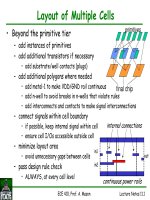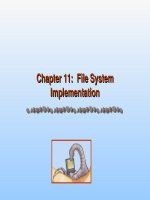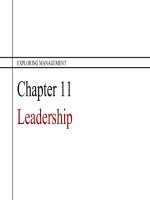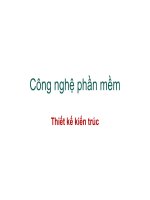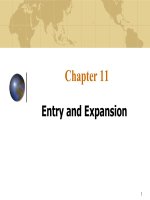Kendall7E ch11
Bạn đang xem bản rút gọn của tài liệu. Xem và tải ngay bản đầy đủ của tài liệu tại đây (416.88 KB, 48 trang )
Designing Effective
Output
Systems Analysis and Design,
7e
Kendall & Kendall
© 2008 Pearson Prentice Hall
11
Learning Objectives
• Understand the objectives for effective
output design
• Relate output content to output methods
inside and outside the organizational
context
• Realize how output bias affects users
• Design display output
• Design tabular and graphic output for users
interacting with decision support systems
• Design a Web site for ecommerce
Kendall & Kendall
11-2
Output
• Information delivered to users
• Output forms
• Hard-copy - printed reports
• Soft-copy - computer screens,
microforms, and audio
• To create output, the analyst
works interactively with the user
until the output is satisfactory
Kendall & Kendall
11-3
Major Topics
• Designing output
• Output technologies
• Factors in choosing an output
technology
• Report design
• Screen design
• Web site design
Kendall & Kendall
11-4
Output Design Objectives
• Serve a specific user or organizational
purpose
• Meaningful to the user
• Deliver the appropriate quantity of output
• Make sure the output is where it is
needed
• Provide output on time
• Choosing the right output method
Kendall & Kendall
11-5
Relating Output Content to
Method
• Content of output must be
considered as interrelated to the
output method
• External – going outside the business
• Internal – staying within the business
Kendall & Kendall
11-6
External Output
• Examples:
• Utility bills
• Advertisements
• Paychecks
• Differs from internal output in:
• Distribution
• Design
• Appearance
Kendall & Kendall
11-7
Internal Output
• Examples:
• Summary reports
• Detailed reports
• Historical reports
• Exception reports
• Might consist of material available
on an intranet
Kendall & Kendall
11-8
Output Technologies
• Printers
• Display screen
• Audio output and Podcasts
• DVD, CD-ROM and CD-RW
• Electronic output
Kendall & Kendall
11-9
Printers
• The trend in printers is toward
increased flexibility
• Key factors of printers:
• Reliability
• Compatibility with software and
hardware
• Manufacturing support
Kendall & Kendall
11-10
Display Screen
• Advantages:
• Result in cost savings
• May be desirable from the user’s
standpoint
• Easier to keep up to date
• Disadvantages:
• Different screen resolutions
• Fonts
Kendall & Kendall
11-11
Video, Audio, and
Animation
• Video
• Combines the impact of audio with a visual
channel
• Audio
• Transient, usually output for the benefit of
one user
• Animation
• The presentation of different images in a
series, one at a time
Kendall & Kendall
11-12
Video Clips
• Supplementing static, printed output
• Distance collaboration
• Showing how to perform an action
• Providing brief training episodes
• Shifting the time of an actual event
by recording it for later output
• Preserving an important occasion
Kendall & Kendall
11-13
Audio
• Sound
• Music
• Sound effects
• Telephone
• Podcasting
• Technique of putting downloadable
voice files on the Web as RSS files
Kendall & Kendall
11-14
Animation
• Animation is composed of four
elements:
• Elemental symbols
• Spatial orientation
• Transition effects
• Alteration effects
Kendall & Kendall
11-15
CD-ROMs and DVDs
• Less vulnerable to damage from
human handling
• Can include full-color text and
graphics as well as audio and video
Kendall & Kendall
11-16
Electronic Output
• Electronic mail (email)
• Faxes
• Bulletin board messages
Kendall & Kendall
11-17
RSS (Really Simple
Syndication)
• A way of gathering and distributing news
and other content from multiple sources
• RSS news readers can either stand alone
or be integrated with your browser as
plug-ins
• Has the advantage of efficiently organizing
news and other information from a variety
of sources chosen by the user
Kendall & Kendall
11-18
Push and Pull Technology
• Pull technology allows the user to
take formatted data from the Web
• Push technology sends solicited or
unsolicited information to a
customer or client
Kendall & Kendall
11-19
Figure 11.2 A comparison of
output methods
Kendall & Kendall
11-20
